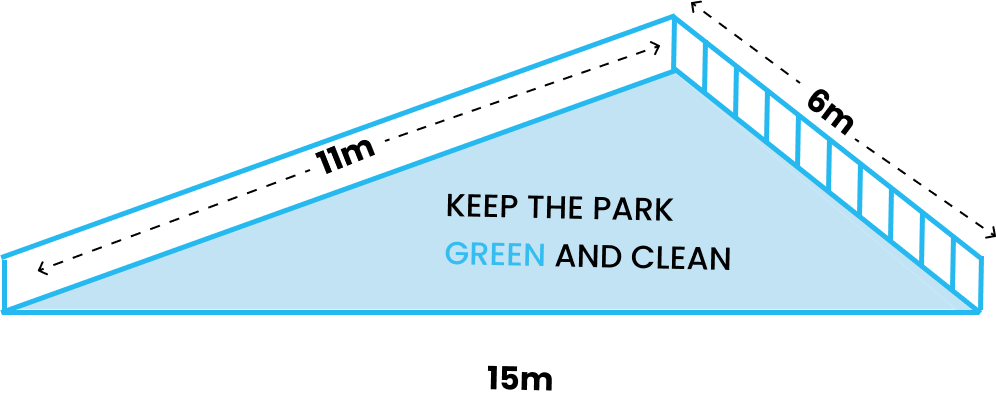Vedantu's Heron's Formula NCERT PDF For Complete Chapter Understanding
FAQs on NCERT Solutions For Class 9 Maths Chapter 10 Heron's Formula
1. What is Heron's formula in NCERT Solutions for Class 9 Maths Chapter 10?
Heron's formula is a mathematical method used in Class 9 Maths Chapter 10 to calculate the area of any triangle when the lengths of all three sides are known. It is expressed as: Area = √[s(s - a)(s - b)(s - c)], where s is the semi-perimeter and a, b, c are the lengths of the triangle’s sides.
2. How do you find the semi-perimeter 's' in Heron's formula for Class 9 NCERT Maths solutions?
The semi-perimeter 's' in Heron’s formula is calculated as s = (a + b + c) / 2, where a, b, and c are the lengths of the three sides of the triangle. Knowing 's' is essential to apply Heron's formula for the area.
3. Can Heron's formula be used for all types of triangles in Class 9 Maths Chapter 10?
Yes, in NCERT Solutions for Class 9 Maths Chapter 10, Heron’s formula applies to all triangles—scalene, isosceles, and equilateral—as long as the lengths of all sides are given.
4. What steps should you follow to solve a problem using Heron's formula as per CBSE 2025-26 NCERT Solutions?
To solve a problem using Heron's formula in Class 9 Maths NCERT Solutions, follow these steps:
- Step 1: Note the lengths of all three sides (a, b, c).
- Step 2: Calculate the semi-perimeter, s = (a + b + c)/2.
- Step 3: Substitute the values into the formula: Area = √[s(s - a)(s - b)(s - c)].
- Step 4: Evaluate to find the area of the triangle.
5. How is altitude related to Heron's formula in the context of NCERT Class 9 Maths Chapter 10 solutions?
The altitude of a triangle can be derived indirectly using Heron's formula. First, calculate the area (A) with Heron’s formula, then use the formula Area = (1/2) × base × height. Rearranging gives the altitude (height): height = (2 × Area)/base.
6. What kind of errors should students avoid when applying Heron's formula in CBSE Class 9 Maths?
Common mistakes to avoid include:
- Using incorrect side lengths.
- Misapplying the formula for semi-perimeter.
- Forgetting to take the square root at the end.
- Mixing up units of measurement.
7. Why is Heron's formula important for solving real-life problems in Class 9 Maths NCERT Solutions?
Heron's formula is vital because it allows finding the area of land plots and other triangular spaces in practical scenarios—even when only side lengths are known. This applicability to irregular triangles makes it essential in fields such as construction and surveying.
8. How do NCERT Solutions for Class 9 Maths Chapter 10 ensure stepwise clarity for students?
NCERT Solutions for Class 9 Maths Chapter 10 Heron's Formula follow a step-by-step breakdown for each exercise problem, including calculation of the semi-perimeter, individual subtractions, and the final square root step, ensuring clarity and adherence to CBSE guidelines.
9. Is there any difference in applying Heron's formula for an equilateral, isosceles, or scalene triangle in NCERT Class 9 Maths?
No, the formula remains the same—but the calculation may simplify for equilateral or isosceles triangles due to equal side lengths. For scalene triangles, all steps must be shown distinctly, as each side is different.
10. What real-world examples are covered in NCERT Solutions for Class 9 Maths Chapter 10 using Heron's formula?
Typical examples in Chapter 10 include calculating areas of traffic signal boards (equilateral triangles), wall spaces for advertising on flyover side walls, or the painted area on park slides—all practical applications where side lengths are known.
11. How can students improve accuracy while solving exercise 10.1 in Class 9 Maths NCERT Solutions?
Students should:
- Write all intermediate steps, especially for subtraction in s–a, s–b, s–c.
- Use exact values (avoid early rounding-off).
- Verify each calculation before substituting into Heron's formula.
- Practice multiple types of triangle problems for proficiency.
12. What is the significance of the semi-perimeter in Heron's formula, as per NCERT Class 9 Maths curriculum?
The semi-perimeter 's' is half the total length of all sides of the triangle. It serves as a crucial intermediary variable in Heron’s formula, linking the side lengths in a way that allows area computation regardless of triangle type.
13. If two sides and the perimeter are known, how can you find the area of a triangle using Chapter 10 solutions?
- Step 1: Subtract the sum of the two known sides from the perimeter to get the third side.
- Step 2: Calculate the semi-perimeter, s = (a + b + c)/2.
- Step 3: Apply Heron's formula to get the area.
14. How does solving Heron's formula questions strengthen mathematical skills for Class 9 students?
Practicing with Heron’s formula develops skills in algebraic manipulation, problem comprehension, and systematic calculation—all fundamental for success in higher-level geometry and trigonometry as per NCERT and CBSE standards.
15. What are the key differences between Heron's formula and conventional base-height methods in Class 9 Maths Chapter 10?
Heron's formula requires only the three side lengths, making it more versatile for irregular triangles, while the base-height method needs a directly measured or given height. Heron's method is especially useful when the triangle’s altitude is not easily determined.







































